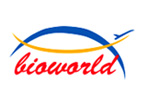Product Name :
CD265 Recombinant Protein Swiss-Prot :
Q9Y6Q6 Host :
E.coli Tag :
Amino acid Sequence :
MIAPPCTSEKHYEHLGRCCNKCEPGKYMSSKCTTTSDSVCLPCGPDEYLDSWNEEDKCLLHKVCDTGKALVAVVAGNSTTPRRCACTAGYHWSQDCECCRRNTECAPGLGAQHPLQLNKDTVCKPCLAGYFSDAFSSTDKCRPWTNCTFLGKRVEHHGTEKSDAVCSSSLPARKPPNEPHVYLP Restriction sites :
NdeI-XhoI Background :
RANK (receptor activator of NF-κB) is a member of the tumor necrosis factor (TNF) receptor subfamily that is activated by its ligand, RANKL (TRANCE/OPGL/ODF), to promote survival of dendritic cells and differentiation of osteoclasts. Although RANK is widely expressed, its cell surface expression may be more restricted to dendritic cells and foreskin fibroblasts. RANK contains a 383-amino acid intracellular domain that associates with specific members of the TRAF family to NF-κB and JNK activiation. RANKL/RANK signaling may also lead to survival signaling through activation of the Akt pathway and an upregulation of survival proteins, including Bcl-xL. RANK signaling has been implicated as a potential therapeutic to inhibit bone loss and arthritis. Soluble :
PBS, 4M Urea, PH7.4 Purification&Purity :
Transferred into competent cells and the supernatant was purified by NI column affinity chromatography and the purity is > 85% (by SDS-PAGE). Storage&Stability :
Store at 4°C short term. Aliquot and store at -20°C long term. Avoid freeze-thaw cycles. Expression vector :
pet-22b(+) BiowMW :
~21kDa Note :
For research use only, not for use in diagnostic procedure. concentration :
CD265 Recombinant Protein Swiss-Prot :
Q9Y6Q6 Host :
E.coli Tag :
Amino acid Sequence :
MIAPPCTSEKHYEHLGRCCNKCEPGKYMSSKCTTTSDSVCLPCGPDEYLDSWNEEDKCLLHKVCDTGKALVAVVAGNSTTPRRCACTAGYHWSQDCECCRRNTECAPGLGAQHPLQLNKDTVCKPCLAGYFSDAFSSTDKCRPWTNCTFLGKRVEHHGTEKSDAVCSSSLPARKPPNEPHVYLP Restriction sites :
NdeI-XhoI Background :
RANK (receptor activator of NF-κB) is a member of the tumor necrosis factor (TNF) receptor subfamily that is activated by its ligand, RANKL (TRANCE/OPGL/ODF), to promote survival of dendritic cells and differentiation of osteoclasts. Although RANK is widely expressed, its cell surface expression may be more restricted to dendritic cells and foreskin fibroblasts. RANK contains a 383-amino acid intracellular domain that associates with specific members of the TRAF family to NF-κB and JNK activiation. RANKL/RANK signaling may also lead to survival signaling through activation of the Akt pathway and an upregulation of survival proteins, including Bcl-xL. RANK signaling has been implicated as a potential therapeutic to inhibit bone loss and arthritis. Soluble :
PBS, 4M Urea, PH7.4 Purification&Purity :
Transferred into competent cells and the supernatant was purified by NI column affinity chromatography and the purity is > 85% (by SDS-PAGE). Storage&Stability :
Store at 4°C short term. Aliquot and store at -20°C long term. Avoid freeze-thaw cycles. Expression vector :
pet-22b(+) BiowMW :
~21kDa Note :
For research use only, not for use in diagnostic procedure. concentration :
Blocking peptide available as NCP0359P

 CD265 Recombinant Protein
CD265 Recombinant Protein 
 Datasheet
Datasheet COA
COA MSDS
MSDS SHIP
SHIP